Um site rápido é essencial para atrair visitantes satisfeitos e obter as melhores classificações nos mecanismos de pesquisa. Isso ocorre porque os mecanismos de pesquisa, como o Google, agora consideram a velocidade do site um importante fator de classificação.
O WP Super Cache é um plug-in popular que cria arquivos HTML estáticos de suas páginas da Web. Isso significa que seu servidor não precisa se esforçar tanto, fazendo com que seu site seja carregado mais rapidamente para os visitantes.
Usamos plug-ins de desempenho como Cloudflare e WP Rocket para melhorar a velocidade do WPBeginner. O WP Super Cache é uma alternativa gratuita que pode melhorar significativamente o desempenho, impulsionar o SEO e melhorar a experiência do usuário para os visitantes do site.
Neste artigo, vamos orientá-lo na instalação e configuração do WP Super Cache em seu site WordPress. Explicaremos cada etapa com clareza, portanto, mesmo que você não seja especialista em tecnologia, poderá acompanhar o processo. No final, você terá um site mais rápido que será apreciado pelos visitantes e pelos mecanismos de pesquisa.
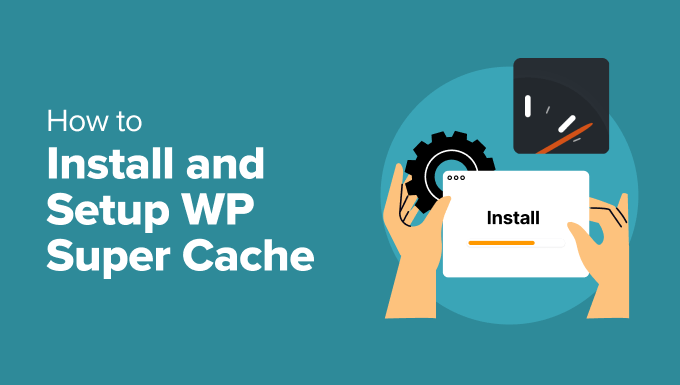
O que é o WP Super Cache e por que você deve usá-lo?
O WP Super Cache é um dos mais populares e melhores plug-ins de cache do WordPress. É uma ferramenta gratuita e tem mais de um milhão de instalações ativas.
O WP Super Cache faz uma cópia em cache de cada página do seu site na forma de um arquivo HTML estático. Dessa forma, sempre que alguém visitar seu site, a versão copiada será exibida rapidamente, em vez de gerar o site inteiro do zero.
Como resultado, a velocidade e o desempenho de seu site WordPress melhoram drasticamente. O plug-in de cache pula várias etapas nos bastidores para garantir que os visitantes não precisem esperar a abertura da página.
Isso melhorará a experiência dos visitantes do seu site. Um site que carrega rapidamente incentiva as pessoas a visitá-lo com mais frequência, levando a mais engajamento e conversões, pois os usuários passam mais tempo em seus posts e páginas.
Além disso, com um site de carregamento rápido, você também pode ver um aumento no SEO do WordPress e nas classificações dos mecanismos de pesquisa. Isso ocorre porque o Google dá uma vantagem significativa a sites mais rápidos, pois usa a velocidade do site como um fator de classificação.
Agora, você está pronto para configurar o WP Super Cache em seu site? Vamos lá!
Configuração do WP Super Cache – a maneira mais fácil
A primeira coisa que você precisa fazer é instalar e ativar o plug-in WP Super Cache em seu site. Para obter mais detalhes, você pode seguir nosso guia sobre como instalar um plug-in do WordPress.
Após a ativação, o WP Super Cache o notificará de que o cache não está ativado em seu site no momento.
Para ativar o cache, vá para Configurações ” WP Super Cache. Em seguida, na guia “Easy”, clique na opção “Caching On”. Depois de fazer isso, clique no botão “Update Status” (Atualizar status).
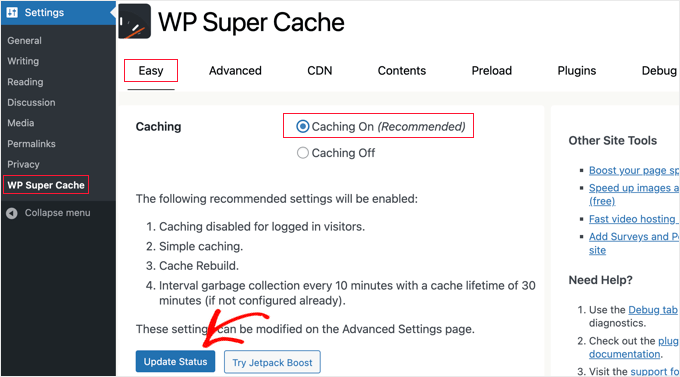
Depois de ativar o cache, você precisará rolar para baixo até a seção “Cache Tester”.
Uma vez lá, você deve clicar no botão “Test Cache” para verificar se está funcionando.
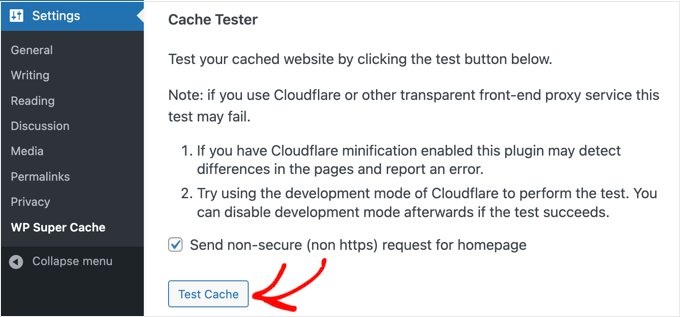
O WP Super Cache buscará seu site WordPress duas vezes e comparará os registros de data e hora das duas páginas. Se os dois carimbos de data/hora forem iguais, isso significa que o cache está funcionando no seu site agora.
Configuração avançada do WP Super Cache
O WP Super Cache é um poderoso plug-in para WordPress que vem com várias opções avançadas. Essas opções podem melhorar ainda mais o desempenho do seu site e lhe dar mais controle sobre como o plug-in armazenará seu site em cache.
Ativar o cache
Para configurar o WP Super Cache com opções avançadas, vá para a guia “Advanced” (Avançado) nas configurações do plug-in WP Super Cache. Em seguida, clique na caixa de seleção “Enable Caching” (Ativar cache).
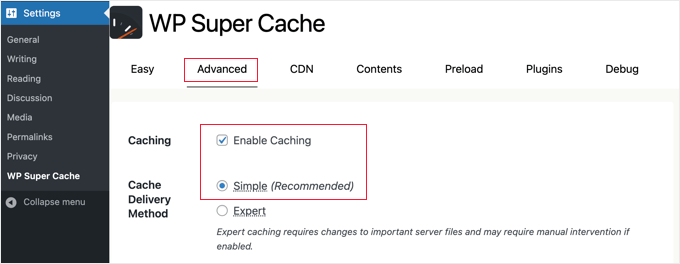
Abaixo do cache, você verá opções para o “Método de entrega de cache”. Recomendamos usar a opção “Simple” se você for iniciante e não estiver familiarizado com a edição dos arquivos do servidor.
Depois de escolher sua opção de cache, certifique-se de clicar no botão “Update Status” (Atualizar status).
Ativar a compactação no WP Super Cache
A compactação permite que o WP Super Cache forneça arquivos em cache como arquivos compactados, o que melhora o tempo de carregamento. Esses arquivos são menores e podem ser baixados pelos navegadores mais rapidamente.
Para ativar a compactação, role para baixo até a seção “Diversos” na guia “Configurações avançadas” e marque a caixa que diz “Compactar páginas para que elas sejam servidas mais rapidamente aos visitantes”.

Mais uma vez, clique no botão “Update Status” (Atualizar status) para salvar suas alterações.
Ativar o cache dinâmico
Se você quiser manter certas partes de uma página da Web dinâmicas durante o armazenamento em cache, o WP Super Cache oferece uma opção para isso.
A ativação do cache dinâmico é útil em determinadas situações, especialmente se você tiver páginas com conteúdo que muda com frequência. Por exemplo, você pode acelerar as páginas que contêm anúncios permitindo o armazenamento em cache dinâmico.
Para ativar essa opção, vá até a seção “Advanced” (Avançado) e clique na caixa de seleção “Enable dynamic caching” (Ativar cache dinâmico).

Certifique-se de salvar suas alterações quando terminar.
Configurar tempo de expiração e coleta de lixo
O WP Super Cache também permite que você configure o tempo de expiração e a frequência da exclusão de páginas em cache do seu servidor.
Para começar, basta rolar para baixo até a seção “Expiry Time & Garbage Collection” (Tempo de expiração e coleta de lixo) na guia “Advanced” (Avançado) para configurá-lo.
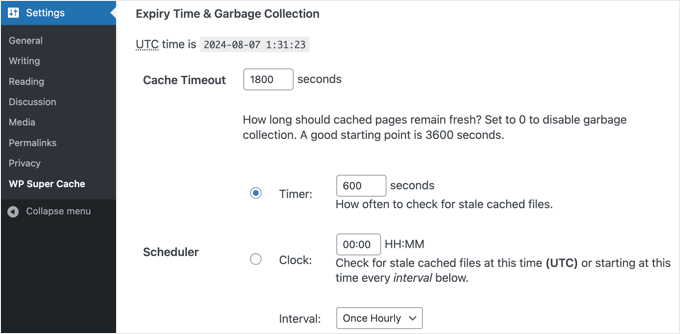
O “Cache Timeout” informa ao plug-in para remover a página em cache e executar um novo cache. O plug-in o definirá como 1800 segundos por padrão, o que é ótimo para um site de alto tráfego.
No entanto, se você tiver um site novo que não recebe muito tráfego, 3600 segundos é um bom ponto de partida.
Além disso, você pode programar um horário para que o plug-in verifique se há arquivos em cache obsoletos e os remova.
Quando terminar de fazer suas seleções, você precisará clicar no botão “Change Expiration” (Alterar vencimento) para salvar suas alterações.
Especifique as páginas que você não quer que sejam armazenadas em cache
Por padrão, o plug-in armazenará em cache todas as páginas do seu site. Isso pode aumentar o tamanho de seus arquivos de cache e usar mais recursos. No entanto, o WP Super Cache permite que você escolha as páginas que não deseja armazenar em cache.
Você pode rolar para baixo até a seção “Rejected URL Strings” (Cadeias de URL rejeitadas) na guia “Advanced” (Avançado) para usar esse recurso. Na caixa de texto, digite a cadeia de URLs das páginas que você não deseja que o plug-in armazene em cache.
Por exemplo, se você tiver uma loja de comércio eletrônico, poderá excluir páginas que os visitantes não visitam com frequência e economizar recursos do servidor. Essas podem ser a página de checkout, a página da conta e a página de agradecimento.
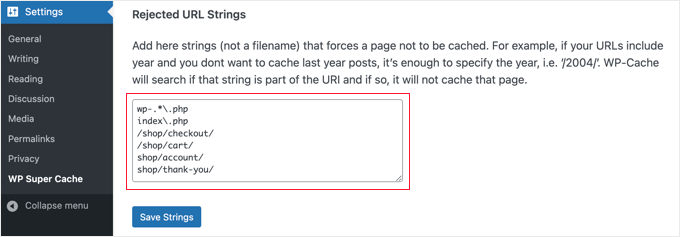
Quando terminar, não se esqueça de clicar no botão “Save Strings”.
Como configurar o WP Super Cache para funcionar com sua CDN
Se você também estiver usando um serviço de CDN (Content Delivery Network) para acelerar o seu site, poderá configurar o WP Super Cache para trabalhar com ele. Caso contrário, poderá ignorar esta seção com segurança.
Uma CDN é uma rede de servidores distribuídos em diferentes localizações geográficas, que ajuda a fornecer conteúdo rapidamente aos seus visitantes. Para obter mais detalhes, dê uma olhada em nosso infográfico sobre por que você precisa de uma CDN.
Dica: recomendamos usar o Cloudflare porque é um provedor de CDN gratuito e fácil de configurar. Consulte nosso tutorial sobre como configurar a CDN gratuita da Cloudflare em seu site WordPress.
Para configurar o WP Super Cache para funcionar com sua CDN, clique na guia CDN em suas configurações. Em seguida, marque a caixa ao lado da opção “Enable CDN Support” (Ativar suporte a CDN).
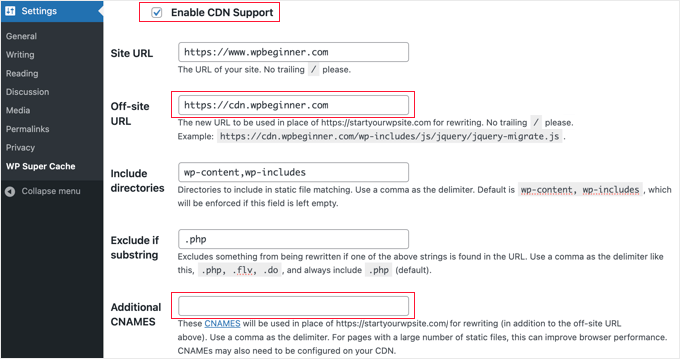
Em seguida, você precisa inserir seu “URL externo”. Essa é a “zona de extração” da CDN, que é a URL onde seus arquivos são armazenados na CDN.
A configuração aqui depende de seu serviço de CDN, mas aqui estão algumas dicas:
- Se estiver usando o Cloudflare, deixe esse campo em branco. O WP Super Cache detectará e trabalhará automaticamente com o Cloudflare.
- Se estiver usando um serviço CDN diferente, insira algo como: https:
//cdn.wpbeginner.com.Certifique-se de substituir “wpbeginner.com” pelo nome de domínio de seu site. - Em caso de dúvida, você pode fazer login no serviço de CDN e verificar a configuração do painel da conta para “domínio”, “domínio CDN” ou “URL CDN”.
Se você souber que sua CDN tem vários URLs, poderá inseri-los no campo “Additional CNAMES”, como: http://cdn1.wpbeginner.com, http://cdn2.wpbeginner.com, http://cdn3.wpbeginner.com. Caso contrário, você deve deixar esse campo em branco.
Você pode deixar as outras configurações como padrão. Por fim, marque a caixa que diz “Ignorar URLs https para evitar erros de “conteúdo misto”” e clique no botão “Salvar alterações”.
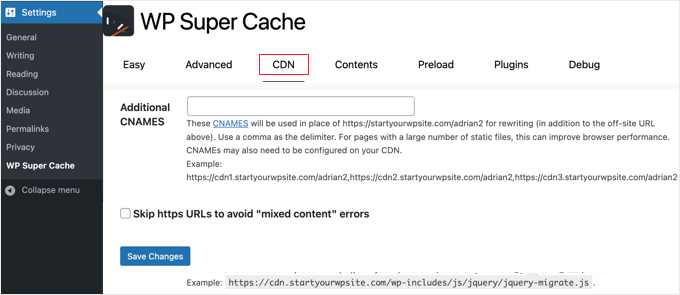
Agora, seu site está pronto para servir conteúdo estático de uma CDN.
Servir um site estático com o WP Super Cache
O modo de pré-carregamento no WP Super Cache permite que você crie arquivos estáticos de supercache para todas as suas postagens e páginas e sirva um site estático. Dessa forma, seu conteúdo será carregado rapidamente sempre que alguém visitar seu site.
Um arquivo estático de supercache ajuda a conservar os recursos do servidor, servir um site antigo que não está mais sendo atualizado e melhorar a velocidade do site servindo somente conteúdo estático.
Para começar, vá até a guia “Preload” (Pré-carregamento) no plug-in WP Super Cache. Em seguida, você pode definir o tempo para atualizar os arquivos de cache pré-carregados.
Por padrão, o plug-in o definirá para 600 minutos, mas você pode diminuir o tempo se publicar vários artigos todos os dias.
Lembre-se de que o pré-carregamento de todo o seu site WordPress leva algum tempo e consome muitos recursos do seu servidor. Você pode deixá-lo em 0 se não quiser que seus arquivos estáticos expirem nunca, a menos que você atualize manualmente o cache.
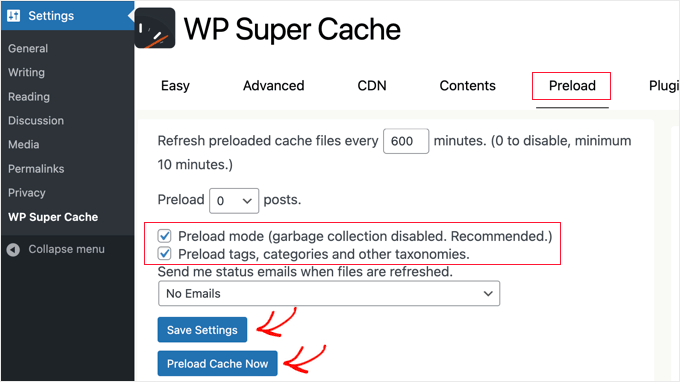
Depois disso, certifique-se de marcar as caixas para “Modo de pré-carregamento (coleta de lixo desativada. Recomendado)”. Você também pode ativar pré-carregamentos para diferentes tags, categorias e outras taxonomias em seu site.
O plug-in também oferece uma opção para receber alertas por e-mail sempre que seus arquivos forem atualizados. Por padrão, ele usará a configuração “No Email”, mas você pode alterá-la escolhendo uma opção no menu suspenso.
Quando terminar, salve suas configurações e clique no botão “Preload Cache Now”.
Guias especializados sobre o cache do WordPress
Esperamos que este guia tenha ajudado você a configurar o WP Super Cache em seu blog do WordPress. Talvez você queira ver alguns outros artigos relacionados ao cache do WordPress:
- Como corrigir facilmente o aviso de cache do navegador Leverage no WordPress
- Como limpar seu cache no WordPress (passo a passo)
- Melhores plug-ins de cache do WordPress para acelerar seu site
- LiteSpeed Cache vs. WP Rocket – Qual é o melhor?
- Como instalar e configurar corretamente o WP Rocket no WordPress
- Como instalar e configurar o W3 Total Cache para iniciantes
- O guia definitivo para aumentar a velocidade e o desempenho do WordPress
- Como acelerar o desempenho do WooCommerce
Se você gostou deste artigo, inscreva-se em nosso canal do YouTube para receber tutoriais em vídeo sobre o WordPress. Você também pode nos encontrar no Twitter e no Facebook.





Anze
Hey; I have a question – so preload mode enabled does not deletes old cached files – but does that means then when preloaded files are refreshed, the old ones are deleted and replaced, or does it just adding files, which would mean space on server would eventually run out?
WPBeginner Support
When the page is preloaded a new time, the old preloaded version would be deleted and replaced.
Admin
James Omeke
Thanks so much . This was very helpful.
I got my website up and running now
WPBeginner Support
You’re welcome, glad our guide was helpful!
Admin
Mike Royden
Plug in installed, but can’t get past this;
Permalink Structure Error
A custom url or permalink structure is required for this plugin to work correctly. Please go to the Permalinks Options Page to configure your permalinks.
I have gone to the Permalinks Options Page to configure your permalinks, but can’t see where I’m going wrong. Going round in circles, please help. Thanks
WPBeginner Support
You would want to ensure your permalinks are not set to plain for that error. We recommend using the Post name structure.
Admin
Mike Royden
Sorted! Many thanks for your advice and taking the time to reply. Cheers.
Katherine
I’m trying to set up this plug in to get the best results, and I’m not tech-savvy at all. Your Wp advanced cache set up section is not the same as the current plugin advanced options.
WPBeginner Support
Thank you for letting us know, we will be sure to take a look into this and update our article when able.
Admin
Simon
I was able to speed up my homepage significantly but unfortunately it only worked for the homepage. The subpages like i.e. ‘Services’ are still really slow.
What could be the problem?
WPBeginner Support
You would want to run a speed test for that using our guide below to figure that out:
https://www.wpbeginner.com/beginners-guide/how-to-properly-run-a-website-speed-test-best-tools/
Admin
Rainey
Unable to activate the plugin. I get a warning message that a .php file already exists and I should manually delete it before using the plugin. Since I am not a techie I do not know where to go to delete the file. If you could put language in your update to the tutorial to guide us would be really helpful.
WPBeginner Support
For that error, you may want to follow our guide below:
https://www.wpbeginner.com/wp-tutorials/how-to-fix-destination-folder-already-exists-error-in-wordpress/
Admin
Paul
This post is dated. When will this post be updated? Would like to know the current status of WP Super Cache?
WPBeginner Support
Thank you for letting us know, we do not have a specific date that content will be updated but we will take a look into updating this article
Admin
Nic
Is there a way to export settings once you get done?
WPBeginner Support
At the moment WP Super Cache does not have a built-in option to export settings.
Admin
ShoaiB
Thank you for this Awesome Guide.
I’m using WP Super Cache (Version 1.7.0 ). In the above tutorial, many features are not included. plz, Update Post.
WPBeginner Support
Thank you for your request, we will look into updating the post
Admin
Christopher
not as easy as described…
A custom url or permalink structure is required for this plugin to work correctly. Please go to the Permalinks Options Page to configure your permalinks.
WPBeginner Support
Thank you for reminding us of that, we’ll be sure to look into updating the article for clarification.
Admin
Ana
Hello Support!
Thank you for all your work, I’m a complete newbie and without you, I don’t know how I’d manage.
I’m confused as regards what off-site URLs and CNames are, so I’m unable to fill in that in the form. Do I have to refer to somewhere on my page to find out or do I just create it my indicating something?
Just in case it affects somehow I’d like to inform that I run a multisite.
Thank you so much & hope you can help me,
Ana
WPBeginner Support
Hi Ana,
The off site URL is the URL of your CDN location and CNames are different pullzones you have created on your CDN server. If you are not using a CDN, then you don’t need to make any changes to these settings.
Admin
krishna
can i use this plugin for testing in localhost ??
i installed this plugin in localhost and in “Cache Contents” nothing cached
displaying this …
WP-Cache (0KB)
0 Cached Pages
0 Expired Pages
WP-Super-Cache (0KB)
0 Cached Pages
0 Expired Pages
is it because i can’t use cache plugin in localhost or some other issue ?
Hardik
There is nothing called MOD_REWRITE. Everything from that step seems completely different. Please update the tutorial.
Mike
No matter what settings I use Pingdom still gives me an F and says “The following cacheable resources have a short freshness lifetime. Specify an expiration at least one week in the future for the following resources:” and I see and “expiration not specified” message in the details. Am I missing a setting?
Akshay
Hi Team ,
Thanks for the amazing article .
I have installed WP Super Cache with cloudflare (newbie blogger).
Can you please help me, how can I integrate cloudflare with WP super cache .
I did not found any articles or vidoes for the same .
I thought of installing WP Total , but it has not releasedthe update for recent wordpress version 4.8.1
Thank You
Sumaiya
Hi, I wanted to speed up my site. I used this guide and customized the settings as you shown. But before installing this plugin I tested my site speed it was 4.20 sec. But after installing I check it was 6.78 sec. Why is it like this? please guide me well.
WPBeginner Support
Hi Sumaiya,
Please test it again. If the result persists, then deactivate the plugin.
Admin
Rajeev jaiswal
hello sir, I’m trying to integrate js and CSS code elements in twenty-seventeen WordPress theme. I use enqueue methods but it does not work, so suggest me to all about.
Sara
I just downloaded WP Super Cache and the “Advanced” Page doesn’t have the same setup (or some of the same options!) as your screenshot and instructions. Are those dates, or did I somehow end up with an older version of the plugin?
Carrie
Same here, my settings are different.
Abner
Hi guys – Thanks for sharing this. I am using wp super cache and my wordpress is 4.0.1. At first, i don’t have any problem. Until recently, having a problem. My post did not appear on my website. I tried to put the caching off and my post appear. After that, I put the caching on again. My workaround was after posting article to my website, I will put my caching off to appear the post in my website, then after a few minutes, I will put the caching to on.
Few weeks doing that, and now, when I put the caching on, my post will disappear again to my website. As of now, my caching is still off.
Thanks and hope you can help me.
WPBeginner Support
Hi Abner,
Seems like WP Super Cache is not clearing the cache when you publish new content. Please see our article on how to clear cache in WordPress.
Admin
Mark Layton
Hello Support,
Thank You for your help with this issue while trying to install WP Super Cache.
Here is a copy of issue :
Warning! Could not update /var/www/website/wp-config.php! WPCACHEHOME must be set in config file.
Warning! /var/www/website/wp-content/advanced-cache.php does not exist or cannot be updated.
1. If it already exists, please delete the file first.
2. Make /var/www/website/wp-content writable using the chmod command through your ftp or server software. (chmod 777 /var/www/website/wp-content) and refresh this page. This is only a temporary measure and you’ll have to make it read only afterwards again. (Change 777 to 755 in the previous command)
3. Refresh this page to update /var/www/website/wp-content/advanced-cache.php
If that doesn’t work, make sure the file /var/www/website/wp-content/advanced-cache.php doesn’t exist:
1. Open /var/www/website/wp-content/plugins/wp-super-cache/advanced-cache.php$wp_cache_file in a text editor.
2. Change the text CACHEHOME to /var/www/website/wp-content/plugins/wp-super-cache/
3. Save the file and copy it to /var/www/website/wp-content/advanced-cache.php and refresh this page.
Cannot continue… fix previous problems and retry.
Already use your Envira Gallery and WP Forms and those are fantastic.
Should I just use W3 Total Cache instead?
Thank You so much for your help.
Mark Layton
WPBeginner Support
Hey Mark,
You can try following the instructions shown in WP Super Cache. If you find them too complicated, then you can try W3 Total Cache. Good luck
Admin
sheikave Jhurreea
Initially my website was loading for under 8 seconds which is pretty bad. But using your tutorial I was able get 90/100 for desktop performance.
But the mobile platform it remained 74/100. Could you suggest some resources where I could look up too or what is your suggestion.
WPBeginner Support
Hey Sheikave,
Congrats! That’s impressive. You may also want to see our guide on how to fix render-blocking JavaScript and CSS in WordPress.
Admin
Greg
Hi, I’d like to know whether your guidance to choose mod_rewrite to serve cache files still stands as opposed to using PHP or Legacy Caching. I notice since you published your article, WP Super Cache have changed their own recommendation from mod_rewrite to PHP.
Thanks in advance!
Greg
Dillon
Hi there. I’ve followed this tutorial to a T, and for the most part, everything works correctly, but I’m having two problems. First, when I make changes, they don’t appear on the site if I’m logged in. If I log out, they appear just fine. Second, I’m working on a WPMU network, and I only have the plugin installed on one site. But it’s caching the other sites on the network as well. How do I stop it from doing that? Thanks!
Belayet Hossain
This is an awesome guideline for new users.
It helped me a lot.
Thanks from the core of heart.
Sarah
Hi,
I followed your steps because my site was taking over 5s to load but after setting up the WP Super Cache my site wouldn’t load. At all. It was basic HTML – no content, no pictures, just the header…
So, I guess I’m wondering if there’s a laymen’s guide to literally all the terms you use cause I don’t understand websites or programming and I have a website for a start-up NGO so can’t really pay for any help at this point.
Or maybe you could direct me somewhere that will help me understand all this better? I’m a complete novice and confused easily!
Help!
Pedro Moreira
Hello,
I have a “conceptual doubt” about WP Super Cache, that I didn´t see answered neither in your site neither in other sites.
The question is: the structure of my site is finished. In basic terms, it is mainly a site of videos of football, which means that from this day on I will gradually add posts (that include the videos that I refered) and pages (of the teams).
Since that this will be a long and permanent process, I need right now to speed up my site because nowadays is very slow.
My doubt is: when I install and configue this plugin, what does that mean in terms of the updates that I will do in my site (post and pages that I add)?
I mean, if I cache the site today and tomorrow I add a new page or post, what do I have to do in order that these pages or posts will be also cached? – do I just have to require an update of the plugin? If so, how do I do that, is it possible to define that the plugin will update the cache for example once a week?
Thank you!
Best regards.
Bogdan
If i don„t use set up the CDN ,the wp super cache will be work properly ?
WPBeginner Support
Yes, it will work even without CDN.
Admin
Herman
I’m getting an error on the first step where you need to click on caching on and update. You mentioned the following in your article:
“WP Super Cache will fetch your WordPress site twice and will compare the time stamps of both pages. If the both time stamps match then this means that caching is working on your site now.”
This is the place where I get the error. I get a message that says:
Fetching to prime cache: OK
Fetching first copy of FAILED
Fetching second copy of : FAILED
I would be glad if you could help me out.
Sofor
Thank you so much, It works great for me.
Teddy
My site is a coupon site, so code is included on the coupon so it prints out by itself without lots of other junk that is on the page. If I use WP Super Cache, will that code be lost because it’s now a static page? Will people still be able to click on the coupon to print just the coupon?
WPBeginner Support
Hi Teddy,
You will have to test it out first on your computer or in a staging environment.
Admin
Alex
Thanks so much for the the help. Do i have to create a cname record to use the CDN service in WP super cache. Thanks
Stefan Andonov
Hi,
How to preload for several languages, I am using qtranslate, that seems impossible, right?
10x
Stefan
John Johnson
This is an ecommerce site using Exchange from iThemes. With WP Super Cache activated certain pages that need to be refreshed don’t get refreshed i.e. Empty Cart. When you Empty Cart it comes back with the same content or in other words it appears unemptied.
When I deactivate WP Super Cache the problem disappears. It was suggested that I Whitelist the pages that shouldn’t be cached. I am uncertain about how to do that. Any help would be appreciated.
Regards,
John
Dajuan
WP Beginner Staff, when a theme update is applied, or when other plugin updates are made, is WP Super Cache alerted to create new cached versions? Or does the plugin wait until “Expiry Time & Garbage Collection” or a manual cache deletion?
Iosif
Hello,
I am using WP Super Cache, but it seems that my images don’t get cached. Any ideas on how to configure this?
I did have a lazy load plug-in, but it conflicted with my theme, so I deactivated it…
shubhendu
I have just install wp super cache plugin by reading your article but nor js,css and image is not loading at my blog…plz help my site address is
If you dont want to publish is comment because i include my site link PLEASE reply to my email id.
Thanks.
WPBeginner Support
Seems like you have already resolved the issue.
Admin
madhavi jha
hi , i am regular reader of your site , i have setup WP Super Cache plugin as you guide in your blog , but its not working its show only 20/100
please guide me ,i have been tried to solve this problem since last 2 days , please guide me .
nitai roy
Hi,
I followed as you mentioned here. Everything has done perfectly but I could not find this option: “Enable Compression in WP Super Cache:”
Where is it please?
Also, Now how can I know whether it is working perfectly or not?
Thank you very much.
Patel Shoeb
How to Install and Setup WP Super Cache with CloudFlare CDN?
kurakaniz
after updating the plugin it says “.htaccess file may need to be moved” and this error too
A difference between the rules in your .htaccess file and the plugin rewrite rules has been found. This could be simple whitespace differences but you should compare the rules in the file with those below as soon as possible. Click the ’Update Mod_Rewrite Rules’ button to update the rules.
what to do please help
Ron
Same problem here.Anyone help
stephen
I installed everything just as you said but I am still getting 52sec load time and if I tried using gtmetrix I get an error saying the URL does not appear to be an HTML.home page . please help site is
Megan Good
This article was very helpful, and I was able to troubleshoot my issues based on your suggested settings. Thank you for the info!
Omprakash Jaiswal
wp super cache does not work
Permlink Structure Error
A custom url or permalink structure is required for this plugin to work correctly. Please go to the Permalinks Options Page to configure your permalinks.
Hammad
Thank you for your suggestions, I’m trying to apply these settings on my website now. Can you please advise if wp super cache supports minify settings.
I had wp3 total cache and had a score of 97/81 on gtmetrix, after installing wp super cache my score decreased to 82/68.
Imran
Was looking for some great guide for super cache plugin. Now I will try it on my test site.
Thanks for such a nice tutorial
Robert Connor
Some great tips-now i need to go back and fix my site
User
How do I get it to work for Mobile without changing the theme?
cezars
Any info for Rejected User Agents list from the plugin ?
herb
Installed it and got a lower grade E/D on Gtmetrix…switched to W3TC and it gave me and A/B grade.
efiga
Hi
i have a little question , when using this plugin to cashe pages , the google adsense ads will be cashed too ? ,it will show the same ads ?
thank you in advance
WPBeginner Staff
No your Google Ads will not be cached.